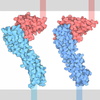[English] 日本語
 Yorodumi
Yorodumi- PDB-4lcw: The structure of human MAIT TCR in complex with MR1-K43A-RL-6-Me-7OH -
+ Open data
Open data
- Basic information
Basic information
| Entry | Database: PDB / ID: 4lcw | ||||||
|---|---|---|---|---|---|---|---|
| Title | The structure of human MAIT TCR in complex with MR1-K43A-RL-6-Me-7OH | ||||||
 Components Components |
| ||||||
 Keywords Keywords | Membrane Protein/Immune System / MHC Class I-related protein / MAIT T cell receptor / Vitamin B2 metabolites / Membrane Protein-Immune System complex | ||||||
| Function / homology |  Function and homology information Function and homology informationpositive regulation of T cell mediated cytotoxicity directed against tumor cell target / antigen processing and presentation of exogenous antigen / MHC class I receptor activity / alpha-beta T cell receptor complex / Translocation of ZAP-70 to Immunological synapse / Phosphorylation of CD3 and TCR zeta chains / beta-2-microglobulin binding / antigen processing and presentation of peptide antigen via MHC class I / alpha-beta T cell activation / Generation of second messenger molecules ...positive regulation of T cell mediated cytotoxicity directed against tumor cell target / antigen processing and presentation of exogenous antigen / MHC class I receptor activity / alpha-beta T cell receptor complex / Translocation of ZAP-70 to Immunological synapse / Phosphorylation of CD3 and TCR zeta chains / beta-2-microglobulin binding / antigen processing and presentation of peptide antigen via MHC class I / alpha-beta T cell activation / Generation of second messenger molecules / Co-inhibition by PD-1 / T cell receptor binding / negative regulation of receptor binding / early endosome lumen / Nef mediated downregulation of MHC class I complex cell surface expression / DAP12 interactions / transferrin transport / cellular response to iron ion / Endosomal/Vacuolar pathway / Antigen Presentation: Folding, assembly and peptide loading of class I MHC / peptide antigen assembly with MHC class II protein complex / cellular response to iron(III) ion / MHC class II protein complex / negative regulation of forebrain neuron differentiation / antigen processing and presentation of exogenous protein antigen via MHC class Ib, TAP-dependent / ER to Golgi transport vesicle membrane / peptide antigen assembly with MHC class I protein complex / regulation of iron ion transport / regulation of erythrocyte differentiation / HFE-transferrin receptor complex / response to molecule of bacterial origin / MHC class I peptide loading complex / T cell mediated cytotoxicity / positive regulation of T cell cytokine production / antigen processing and presentation of endogenous peptide antigen via MHC class I / antigen processing and presentation of exogenous peptide antigen via MHC class II / positive regulation of immune response / MHC class I protein complex / positive regulation of T cell activation / peptide antigen binding / positive regulation of receptor-mediated endocytosis / negative regulation of neurogenesis / cellular response to nicotine / positive regulation of T cell mediated cytotoxicity / multicellular organismal-level iron ion homeostasis / specific granule lumen / phagocytic vesicle membrane / recycling endosome membrane / Interferon gamma signaling / Immunoregulatory interactions between a Lymphoid and a non-Lymphoid cell / negative regulation of epithelial cell proliferation / MHC class II protein complex binding / Modulation by Mtb of host immune system / late endosome membrane / sensory perception of smell / positive regulation of cellular senescence / tertiary granule lumen / Downstream TCR signaling / DAP12 signaling / T cell differentiation in thymus / T cell receptor signaling pathway / negative regulation of neuron projection development / ER-Phagosome pathway / protein refolding / early endosome membrane / defense response to Gram-negative bacterium / protein homotetramerization / adaptive immune response / amyloid fibril formation / intracellular iron ion homeostasis / learning or memory / defense response to Gram-positive bacterium / immune response / endoplasmic reticulum lumen / Amyloid fiber formation / Golgi membrane / lysosomal membrane / innate immune response / external side of plasma membrane / focal adhesion / Neutrophil degranulation / endoplasmic reticulum membrane / SARS-CoV-2 activates/modulates innate and adaptive immune responses / structural molecule activity / endoplasmic reticulum / Golgi apparatus / protein homodimerization activity / extracellular space / extracellular exosome / extracellular region / identical protein binding / membrane / plasma membrane / cytosol Similarity search - Function | ||||||
| Biological species |  Homo sapiens (human) Homo sapiens (human) | ||||||
| Method |  X-RAY DIFFRACTION / X-RAY DIFFRACTION /  SYNCHROTRON / SYNCHROTRON /  MOLECULAR REPLACEMENT / Resolution: 2.4 Å MOLECULAR REPLACEMENT / Resolution: 2.4 Å | ||||||
 Authors Authors | Patel, O. / Rossjohn, J. | ||||||
 Citation Citation |  Journal: J.Exp.Med. / Year: 2013 Journal: J.Exp.Med. / Year: 2013Title: Antigen-loaded MR1 tetramers define T cell receptor heterogeneity in mucosal-associated invariant T cells. Authors: Reantragoon, R. / Corbett, A.J. / Sakala, I.G. / Gherardin, N.A. / Furness, J.B. / Chen, Z. / Eckle, S.B. / Uldrich, A.P. / Birkinshaw, R.W. / Patel, O. / Kostenko, L. / Meehan, B. / ...Authors: Reantragoon, R. / Corbett, A.J. / Sakala, I.G. / Gherardin, N.A. / Furness, J.B. / Chen, Z. / Eckle, S.B. / Uldrich, A.P. / Birkinshaw, R.W. / Patel, O. / Kostenko, L. / Meehan, B. / Kedzierska, K. / Liu, L. / Fairlie, D.P. / Hansen, T.H. / Godfrey, D.I. / Rossjohn, J. / McCluskey, J. / Kjer-Nielsen, L. | ||||||
| History |
|
- Structure visualization
Structure visualization
| Structure viewer | Molecule:  Molmil Molmil Jmol/JSmol Jmol/JSmol |
|---|
- Downloads & links
Downloads & links
- Download
Download
| PDBx/mmCIF format |  4lcw.cif.gz 4lcw.cif.gz | 329.8 KB | Display |  PDBx/mmCIF format PDBx/mmCIF format |
|---|---|---|---|---|
| PDB format |  pdb4lcw.ent.gz pdb4lcw.ent.gz | 262 KB | Display |  PDB format PDB format |
| PDBx/mmJSON format |  4lcw.json.gz 4lcw.json.gz | Tree view |  PDBx/mmJSON format PDBx/mmJSON format | |
| Others |  Other downloads Other downloads |
-Validation report
| Summary document |  4lcw_validation.pdf.gz 4lcw_validation.pdf.gz | 1.1 MB | Display |  wwPDB validaton report wwPDB validaton report |
|---|---|---|---|---|
| Full document |  4lcw_full_validation.pdf.gz 4lcw_full_validation.pdf.gz | 1.1 MB | Display | |
| Data in XML |  4lcw_validation.xml.gz 4lcw_validation.xml.gz | 56.6 KB | Display | |
| Data in CIF |  4lcw_validation.cif.gz 4lcw_validation.cif.gz | 79.6 KB | Display | |
| Arichive directory |  https://data.pdbj.org/pub/pdb/validation_reports/lc/4lcw https://data.pdbj.org/pub/pdb/validation_reports/lc/4lcw ftp://data.pdbj.org/pub/pdb/validation_reports/lc/4lcw ftp://data.pdbj.org/pub/pdb/validation_reports/lc/4lcw | HTTPS FTP |
-Related structure data
| Related structure data |  4l4vS S: Starting model for refinement |
|---|---|
| Similar structure data |
- Links
Links
- Assembly
Assembly
| Deposited unit | 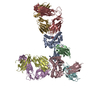
| ||||||||
|---|---|---|---|---|---|---|---|---|---|
| 1 | 
| ||||||||
| 2 | 
| ||||||||
| Unit cell |
|
- Components
Components
-Protein , 2 types, 4 molecules ACBF
| #1: Protein | Mass: 31653.568 Da / Num. of mol.: 2 / Fragment: extracellular domain, residues 23-292 / Mutation: C261S, K43A Source method: isolated from a genetically manipulated source Source: (gene. exp.)  Homo sapiens (human) / Gene: MR1 / Plasmid: pET30 / Production host: Homo sapiens (human) / Gene: MR1 / Plasmid: pET30 / Production host:  #2: Protein | Mass: 11748.160 Da / Num. of mol.: 2 Source method: isolated from a genetically manipulated source Source: (gene. exp.)  Homo sapiens (human) / Gene: B2M / Plasmid: pET30 / Production host: Homo sapiens (human) / Gene: B2M / Plasmid: pET30 / Production host:  |
|---|
-MAIT T cell receptor ... , 2 types, 4 molecules DGEH
| #3: Protein | Mass: 22650.072 Da / Num. of mol.: 2 Source method: isolated from a genetically manipulated source Source: (gene. exp.)  Homo sapiens (human) / Gene: TCR alpha / Plasmid: pET30 / Production host: Homo sapiens (human) / Gene: TCR alpha / Plasmid: pET30 / Production host:  #4: Protein | Mass: 27546.562 Da / Num. of mol.: 2 Source method: isolated from a genetically manipulated source Source: (gene. exp.)  Homo sapiens (human) / Gene: TCR beta / Plasmid: pET30 / Production host: Homo sapiens (human) / Gene: TCR beta / Plasmid: pET30 / Production host:  |
|---|
-Non-polymers , 3 types, 337 molecules 




| #5: Chemical | ChemComp-GOL / | ||
|---|---|---|---|
| #6: Chemical | | #7: Water | ChemComp-HOH / | |
-Details
| Has protein modification | Y |
|---|
-Experimental details
-Experiment
| Experiment | Method:  X-RAY DIFFRACTION / Number of used crystals: 1 X-RAY DIFFRACTION / Number of used crystals: 1 |
|---|
- Sample preparation
Sample preparation
| Crystal | Density Matthews: 2.77 Å3/Da / Density % sol: 55.57 % |
|---|---|
| Crystal grow | Temperature: 277 K / Method: vapor diffusion, hanging drop / pH: 6.5 Details: 0.2M sodium acetate, 0.1M Bis-Tris-Propane pH 6.5 and 20% PEG 3350, VAPOR DIFFUSION, HANGING DROP, temperature 277K |
-Data collection
| Diffraction | Mean temperature: 100 K |
|---|---|
| Diffraction source | Source:  SYNCHROTRON / Site: SYNCHROTRON / Site:  Australian Synchrotron Australian Synchrotron  / Beamline: MX2 / Wavelength: 0.95453 Å / Beamline: MX2 / Wavelength: 0.95453 Å |
| Detector | Type: ADSC QUANTUM 315r / Detector: CCD / Date: Mar 7, 2013 |
| Radiation | Protocol: SINGLE WAVELENGTH / Monochromatic (M) / Laue (L): M / Scattering type: x-ray |
| Radiation wavelength | Wavelength: 0.95453 Å / Relative weight: 1 |
| Reflection | Resolution: 2.4→75 Å / Num. all: 80366 / Num. obs: 80366 / % possible obs: 99.8 % / Observed criterion σ(F): 0 / Observed criterion σ(I): 0 / Redundancy: 4.3 % / Biso Wilson estimate: 42.74 Å2 / Rmerge(I) obs: 0.146 / Net I/σ(I): 7.4 |
| Reflection shell | Resolution: 2.4→2.5 Å / Redundancy: 4.4 % / Rmerge(I) obs: 0.686 / Mean I/σ(I) obs: 2.1 / Num. unique all: 11654 / % possible all: 99.9 |
- Processing
Processing
| Software |
| ||||||||||||||||||||||||||||||||||||||||||||||||||||||||||||||||||||||||||||||||||||||||||||||||||||||||||||||||||
|---|---|---|---|---|---|---|---|---|---|---|---|---|---|---|---|---|---|---|---|---|---|---|---|---|---|---|---|---|---|---|---|---|---|---|---|---|---|---|---|---|---|---|---|---|---|---|---|---|---|---|---|---|---|---|---|---|---|---|---|---|---|---|---|---|---|---|---|---|---|---|---|---|---|---|---|---|---|---|---|---|---|---|---|---|---|---|---|---|---|---|---|---|---|---|---|---|---|---|---|---|---|---|---|---|---|---|---|---|---|---|---|---|---|---|---|
| Refinement | Method to determine structure:  MOLECULAR REPLACEMENT MOLECULAR REPLACEMENTStarting model: PDB entry 4L4V Resolution: 2.4→35.14 Å / Cor.coef. Fo:Fc: 0.9241 / Cor.coef. Fo:Fc free: 0.8894 / SU R Cruickshank DPI: 0.284 / Cross valid method: THROUGHOUT / σ(F): 0 / Stereochemistry target values: Engh & Huber
| ||||||||||||||||||||||||||||||||||||||||||||||||||||||||||||||||||||||||||||||||||||||||||||||||||||||||||||||||||
| Displacement parameters | Biso mean: 35.27 Å2
| ||||||||||||||||||||||||||||||||||||||||||||||||||||||||||||||||||||||||||||||||||||||||||||||||||||||||||||||||||
| Refine analyze | Luzzati coordinate error obs: 0.271 Å | ||||||||||||||||||||||||||||||||||||||||||||||||||||||||||||||||||||||||||||||||||||||||||||||||||||||||||||||||||
| Refinement step | Cycle: LAST / Resolution: 2.4→35.14 Å
| ||||||||||||||||||||||||||||||||||||||||||||||||||||||||||||||||||||||||||||||||||||||||||||||||||||||||||||||||||
| Refine LS restraints |
| ||||||||||||||||||||||||||||||||||||||||||||||||||||||||||||||||||||||||||||||||||||||||||||||||||||||||||||||||||
| LS refinement shell | Resolution: 2.4→2.46 Å / Total num. of bins used: 20
|
 Movie
Movie Controller
Controller



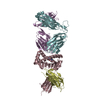



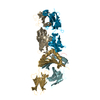

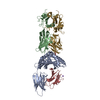

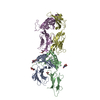
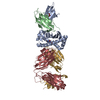
 PDBj
PDBj





